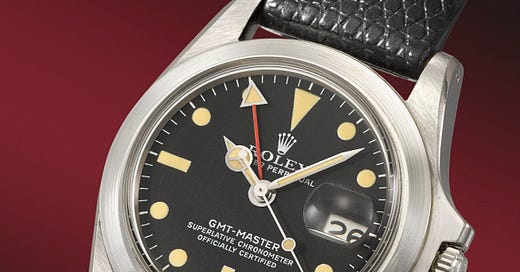The Fourth Wheel, Issue 77
Chaos at Christie's, and why it's time for Patek Philippe to come down from its perch
Hello and welcome back to The Fourth Wheel, the weekly watch newsletter that as you read this is now revising its low estimate and will contain roughly 150 per cent more words than you bargained for. I have also been promised by an anonymous yet trusted acquaintance that in the event nobody reads it, he will read it himself a thousand times over and my traffic targets1 will be met.
I will also take this moment to provide The Fourth Wheel’s inaugural sustainability report. All newsletters are organically created in South East London, incurring no air miles or manufacturing waste2. All third party content is sourced from the finest, cleanest suppliers3. Environmental impact? Well, I’d like to think so. But on a very small carbon footprint - even smaller when you think that while I’m writing this, I’m almost certainly pretending to be doing something else.
No prizes for guessing the two main topics on the agenda today. What about the GPHG, you might be asking? Next week, my friends. I am but one man, and reacting to the awards by 10:10 the next morning is a tall order.4
The Fourth Wheel is a reader-supported publication with no advertising, sponsorship or commercial partnerships to influence its content. It is made possible by the generous support of its readers: if you think watch journalism could do with a voice that exists outside of the usual media dynamic, please consider taking out a paid subscription. You can start with a free trial!
Here’s a little taste of what you might have missed recently:
The Only Watch Saga, Part 1, Part 2, Part 3 and Part 4
Hands-on review: The Patek Philippe 6007G
The Twelve Most Significant Watches In The World
A Brief History Of Lightweight Watchmaking
Ask Me Anything: Why the Reverso isn't a sports watch, the best time of day to buy watches and what happened to the Watch Snob
It hasn’t been a good year for Geneva’s auction houses, has it? When they’re not being hoodwinked into selling seven-figure Frankenwatches or seeing entire sales wiped off the calendar by an unexpected onslaught of transparency, they’re moving the goalposts during the match.
For anyone not yet up to speed, Christie’s held an auction on November 6th entitled Passion for Time - An Important Private Collection Of Watches And Timepieces. It was what’s known as a single-owner sale, with all 113 lots coming from the collection of Mohammed Zaman. The sale drew plenty of attention, as it contained some truly unique watches and several absolute grails, like the ‘Marlon Brando’ Rolex GMT-Master.
The auction didn’t start on time, and when it got underway, about an hour later than planned, something odd was happening. Lots were being introduced with higher estimates than listed (either in the catalogues or the live feed, so what you could read was out of sync with what was being said). A saleroom notice appeared:
Every lot in the sale now had the backing of an unknown party, and once bidders figured out what was going on, the result was that most lots sold to paddle 1013, clearly the representative of this guaranteed price. Others have done a good job of reporting on this; I recommend Tony Traina’s piece here - key paragraph below.
"Last night around 6 p.m., a third party from the United States approached us to ask if the seller would consider a third-party guarantee," said Remi Guillemin, Christie's Head of Watches in Europe, immediately after the sale. According to Guillemin, Christie's brought Zaman the third-party guarantee offer, and they inked a deal at 10 a.m. on November 6 (the day of the sale), which is why the auction started 45 minutes late that morning. With the third-party guarantee on every lot in place, Christie's was legally obligated to increase its low estimates to the new, guaranteed price.
I also recommend this week’s ScrewDownCrown, which gives a more blow-by-blow account of exactly how this unfolded and the whys and wherefores of auction guarantees. He also raises a point of protocol: by its own rules, Christie’s did not correctly denote the existence of the guarantee next to the lots. Emphasis his.
The other more obfuscating issue, was Christie’s did not mark the lots with any symbols! The little red symbol shown in their T&Cs, was not in the printed catalogue (perhaps because they didn’t have the guarantor at the time of printing), it was also not present in the PDF catalogue, nor the online listings (even as I type this after the auction), and definitely not in the live auction when they announced the sale room notice above (see video below). That is absurd, is it not?
As others have also pointed out, this action had the effect of completely ignoring any absentee bids placed below the minimum guaranteed price; bids which had been placed in good faith. I haven’t spoken to anyone who was bidding but if you had acquired an interest in a lot from this sale based on its original estimate, and tuned in on the day to find it starting for significantly more, you might well feel upset. You might feel like your trust had been taken for granted. You might feel like you’d been fooled.
Keep reading with a 7-day free trial
Subscribe to The Fourth Wheel to keep reading this post and get 7 days of free access to the full post archives.






